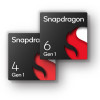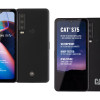Hands On with the Land Rover Explore
Feb 25, 2018, 6:38 PM by Rich Brome @richbrome
updated Aug 9, 2020, 9:50 PM

Bullitt, the company responsible for CAT and Kodak phones, has recently added a new brand to its portfolio: Land Rover. The Land Rover Explore is a tough-yet-capable phone with features designed for the same adventure-seeking crowd that Land Rover vehicles are associated with. Like a Land Rover, the phone is tough and adaptable, while being a bit luxurious as well. Read on for our first impressions.
First off, I should state up front that Bullitt has not decided to bring this particular phone to the US. I was told by the guy in charge of this phone that they do want to bring Land Rover phones to the US, but they haven't yet decided whether to do that with this model or its successor. (In my experience, when someone says that, it means the current model almost definitely won't reach the US. It's not impossible, but something unusual would have to happen to set that in motion.)
The Land Rover Explore is a large, heavy, and extremely solid-feeling phone. Having held many CAT phones (also made by Bullitt), the rugged, strong feeling is no surprise. But some CAT phones feel light and therefore a smidge "cheap". With Land Rover, Bullitt paid more attention to the size/weight ratio, which greatly affects the feeling of quality. In other words, it's on heavy side, and that's actually a good thing, in a way. Imagine a watch that feels like air: is that impressive? No. If you pay good money for a nice watch, you want to feel it on your wrist. This phone isn't obnoxiously heavy, but you'll notice (and perhaps appreciate) its weight.
The materials are truly excellent. Every surface — glass, plastic, and metal — truly feels just notch better than what you'll fine on most other devices. The hard rubber (almost leather-like) material on the back feels comfortable and durable, is easy to grip, seems like it would wear well, ad yet somehow feel just the right amount of luxurious. It's impressive.
The metal frame and sides have similar feeling of quality. The metal side keys have a rough cross-hatch pattern. You do feel like you're operating a more substantial machine than a phone (like, say, a Land Rover) when pressing these keys, and I assume that's the point.

The surprising feature is the magnetic snap-on accessories, which work almost exactly like Moto Mods.
At launch, they offer two huge battery options, one with an extra GPS feature. The standard Land Rover Explore has a generous battery, but the Explore is designed for people who want to... explore. In other words, people who take trips that are far way from cell service and/or involve camping for a day or more. So if you need a phone with 2, 3, or even 4 days of battery life, the Explore has you covered.
Or perhaps you're doing a shorter hike, but you'd prefer to not cut it close. You'd like some buffer in case you get lost or suffer a minor injury and need to stay in touch until help arrives. That would be smart, and the Explore includes several specific SOS features for just that scenario.
One of the battery options also has a special GPS rig embedded, the kind usually found only in dedicated GPS devices, because that kind of antenna won't fit into most phones. This GPS antenna is a bit of ceramic that's only about the size of a postage stamp, but most phones make do with something far smaller. It enables vastly more accurate location sensing, especially when out of range of the cellular network.
That makes it great for hikes in remote locations. You can track your progress and keep a charge no matter where you are.
The battery modules snap on easily thanks to magnets, and stay attached when you want them to. In our time with it, the modules were solidly attached until we really tried to pry them apart from the phone. Then, they did pop off without terrible trouble. But never before we wanted them to. That's key, and they achieved that here, just as Motorola did with its Moto Mods.
The default software experience is very standard Android, and that's very intentional, as Bullitt has been hearing that stock Android is what people want.
Dashboard

But there is a "Dashboard" app that collects customizable widgets onto one screen to help people with various outdoor activities. They seem to focus on sensor and weather data, but that includes the barometer (which not all phones have) and tidal data (which is beyond standard weather forecasts.) It's extremely customizable and looks very handy if you're true outdoorsman.
Comments
No messages
























 Samsung Refreshes Galaxy S Series with S Pen, New Cameras
Samsung Refreshes Galaxy S Series with S Pen, New Cameras
 Qualcomm vs. Bullitt: Satellite Connectivity Comparison and Hands On
Qualcomm vs. Bullitt: Satellite Connectivity Comparison and Hands On
 Qualcomm Intros Snapdragon Chips for 2023's Mid-Range & Affordable 5G Phones
Qualcomm Intros Snapdragon Chips for 2023's Mid-Range & Affordable 5G Phones
 Bullitt Announces First Phones with Satellite Messaging
Bullitt Announces First Phones with Satellite Messaging
 New Bluetooth Dongle Lets Any Phone Message via Satellite
New Bluetooth Dongle Lets Any Phone Message via Satellite


